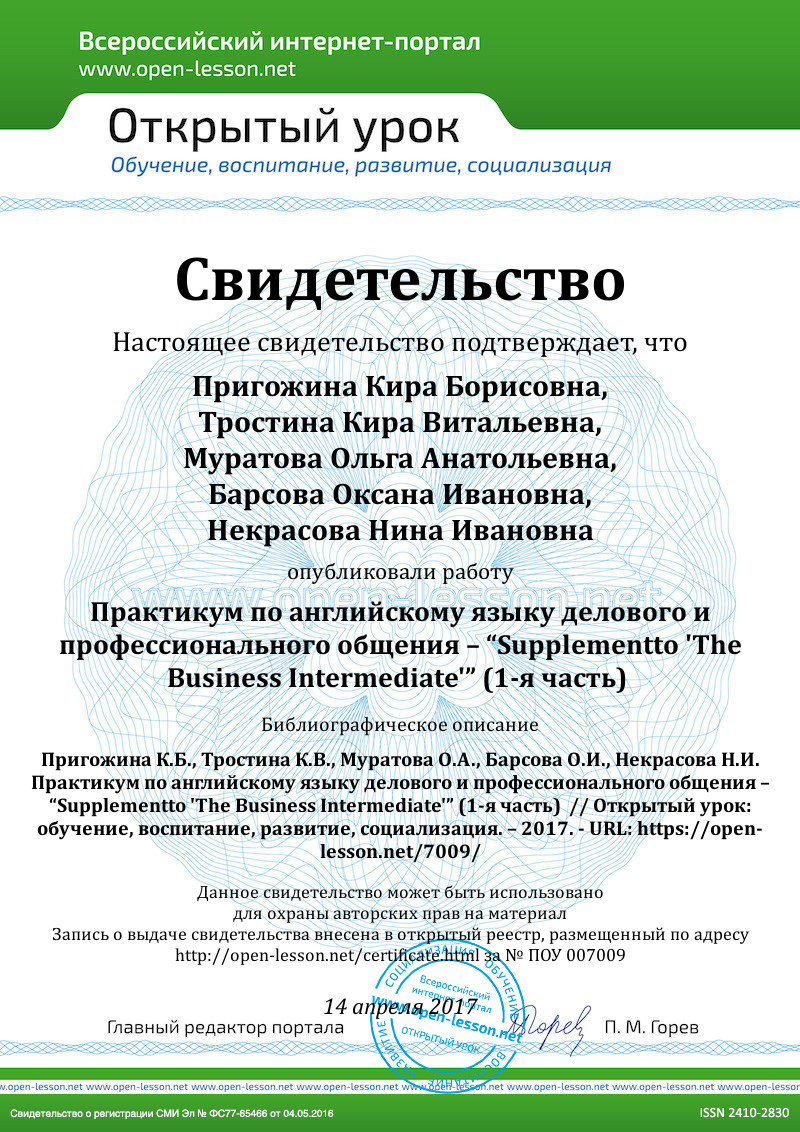CONTENTS
PART 1. Unit 1. Corporate Culture
Subject background
Vocabulary Practice
Grammar Practice
GLOSSARY
PART 2. Unit 2. Customer Support
Subject background
Vocabulary practice
Grammar practice
Reading practice
GLOSSARY
PART 3. Unit 3. Products and Packaging
Subject background
Vocabulary practice
Grammar practice
Reading practice
GLOSSARY
PART 4. Unit 4. Careers
Subject background
Vocabulary practice
Grammar practice
Reading practice
GLOSSARY
PART 1. CORPORATE CULTURE
SUBJECT BACKGROUND
What is corporate culture? There are two answers to this question, one non-academic and one academic. In the non-academic approach, the basic definition of corporate culture is ‘the personality of an organization’, or simply ‘how things are done around here’. It includes:
- core values and beliefs
- corporate ethics
- rules of behaviour.
Corporate culture can be expressed in the company’s mission statement and other communications, in the architectural style or interior decoration of offices, by what people wear to work, by how people address each other, and in the titles given to various employees.
Then, there is the academic approach to corporate culture (often called ‘organizational culture’ in this context). There are many gurus in this field, and perhaps the best known is Geert Hofstede. He has developed a Cultural Orientation Model which classifies cultures based on where they fall on five continuums (highly simplified below):
1. Individual vs. collective
(At what level in the organization is behaviour regulated?)
2. Power distance
(Do less powerful parties accept the existing distribution of power?)
3. Uncertainty avoidance
(Do employees feel threatened by ambiguity? How important are rules?)
4. Dominant values
(What are the dominant values?)
5. Short-term vs. long-term
(Do employees expect immediate or deferred gratification?)
Company culture affects employees in many ways. For example:
- the hours you work, including options such as flextime and telecommuting.
- the work environment, including how employees interact, the degree of competition, and whether it’s a fun or hostile environment.
- the dress code, including accepted styles of clothing and things such as casual days.
- the office space, including things such as cubicles, window offices, and rules regarding display of personal items.
- training and skills development available to employees.
- onsite perks, such as break rooms, gyms, daycare facilities.
- the amount of time outside the office you’re expected to spend with co-workers.
- interaction with other employees, including managers and top management.
The importance of corporate culture is growing as the result of several recent developments, some of which are listed below.
- Companies are encouraging employees to be more responsible and act and think like owners.
- With the decline of more traditional communities (e.g. neighbourhoods) companies are filling their employees’ need to belong to a community.
- Companies are encouraging teamwork.
For all these reasons, organizations need to make their culture explicit, and it is increasingly referred to in mission statements and emphasized in company-sponsored training and company communications.
Useful websites
http://humanresources.about.com/od/organizationalculture
http://www.answers.com/topic/organizational-culture
http://interview.monster.com/articles/compculture
Answer the following questions:
- What is the basic definition of corporate culture in non-academic approach?
- How can it (the corporate culture of a particular organization ) be expressed?
- How are cultures classified in the Cultural Oriented Model developed by G. Hofstede?
- How does company culture affect employees ?
- Why is the importance of corporate culture growing ?
Task 1
Insert the words into the gaps: correlation, values, loyalty, concluded, associated, bureaucracy, rivals, performance, goals, invariably.
Management thinkers have long 1__________ a strong corporate culture – the beliefs, 2_________ and 3__________ that guide the behavior of a firm’s employees – with superior long-term 4__________. The theory is that strong cultures can help workers march to the same drummer; create high levels of employee 5__________ and motivation; and provide the company with structure and controls, without the need for innovation-stifling 6__________.
Scientific analysis conducted by a team at HarvardBusinessSchool showed a positive 7__________ between strong cultures and long-term economic success, but it was a weaker association than most management theorists would have expected. Strong-cultured firms seemed almost as likely to perform poorly as their weak-cultured 8__________. The popular view that a strong corporate culture 9__________ leads to success, the team 10__________, was “just plain wrong”.
Task 2
Choose the best variant:
1. CEO is a person__________.
a) responsible for giving info to people inside and outside a company]
b) with the most authority in everyday management of a company
c) with the responsibility with everyday management of the operations or activities of a company
2. Board of Directors are appointed by ___________.
a) CEO
b) managers
c) shareholders
3. Senior managers report directly to__________.
a) CEO
b) Board of Directors
c) Chief Financial Officer
4. Workers in IT department___________.
a) study electronic processes for storing info and making it available
b) study ways of doing things that make use of materials which are available locally or are not difficult to repair
c) develop technological products that are designed for a small area of a market
5. Shareholders are people who___________.
a) own shares of a certain company
b) take an active part in the running of the business
c) have an important position in a company
6. A system of authority with different levels, one above the other, is _.
a) autonomy
b) hierarchy
c) pyramid
Task 3
Complete a manager’s vision of the company using the following words:
outsourced, functional, chief, shareholders, flexibility, workforce, effectiveness, stake, flatter, layers, stakeholders, hierarchy, empowered
A company’s 1__________ responsibility used to be to its 2__________, but these days we prefer to talk about 3___________, not just the people with a financial 4__________in the company, but everyonewho has an interest in the way it’s run. A big change in the organization of this company is that we now have a much 5__________ structure, instead of the old 6__________. Now a lot of work is 7___________. So, we are a 8__________ company, with fewer 9___________ of management. We work in cross-10__________ teams, which gives us much greater 11__________. And we aim to have 12__________ rather than simply loyal 13__________.
